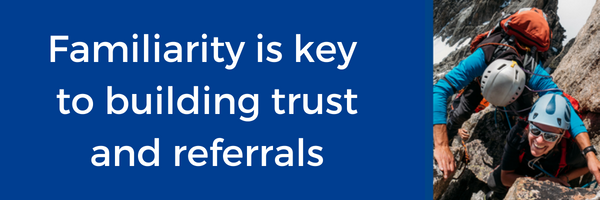Building Trust Means Staying Top of Mind
/Recently I talked about the findings from a piece of research that Vanguard did in 2017. You can read about that here.
I am pretty keen on the old market research, and did some of my own with consumers who have seen an adviser for the first time in the last year or so. There were lots of interesting findings, but one that was seriously concerning. It turns out, that your clients aren’t really sure if they can trust you, even after they have implemented your advice! One caveat, this is for consumers who have seen an adviser for the first time. People who are onto their second or third adviser were pretty confident that they could tell good advice from bad.
There you are, you’ve worked hard to get to know your clients, and give them quality advice, prepared and presented SOAs, dealt with product providers, implemented the advice… and your clients STILL aren’t sure if they’ve done the right thing by going along with what you’ve recommended. It’s no wonder that it’s hard to get a referral from a first-time planning client.
So what are you to do? Well, it turns out that familiarity is actually a key driver of trust. Even though it wasn’t investigated specifically by Vanguard, their report does show that the longer the advice relationship has gone on, the higher the level of trust is. This is the familiarity principle at work.
Here’s the definition of the familiarity principle according to Wikipedia “The mere-exposure effect is a psychological phenomenon by which people tend to develop a preference for things merely because they are familiar with them. In social psychology, this effect is sometimes called the familiarity principle. In studies of interpersonal attraction, the more often a person is seen by someone, the more pleasing and likeable that person appears to be.”
If familiarity is important, then how do you make it happen? For a start, you might want to regularly check in with your clients. Many CRMs will allow you to send bulk messages. The CRM I use, Contactually, also allows you to personalise each message which is handy. A quick "it’s been a month since we finished implementing your strategy, how are you feeling about it?" shows your clients that you are thinking about them, and gives them the opportunity to clarify anything they aren’t sure about.
And then of course, there is your newsletter. Getting something out the door to all your clients every month, even if it’s just a link to a couple of articles that you think they might find interesting, demonstrates that you are taking time and making an effort to keep in touch. And even if consumers see your newsletter and bin it immediately, they have still noticed that they have received something from you, and this will continue to build familiarity, which is key to trust.
And reading the last part of the definition above again you can see the words “the more often a person is seen by someone” are included. This suggests to me that video is a great way to keep in touch with your clients, or at the very least, your photo at the end of your newsletter. Yes, I know it’s naff! But it really does help. When you are only seeing your clients every 6 or 12 months, and they are paying you thousands of dollars, you want to make sure they feel good about the relationship.
And finally, when it comes to familiarity, I think everyone wants to see that you are familiar with their goals, and that they are making progress towards those goals. I know some advisers send out an automated portfolio report every month from Xplan. This isn’t quite a personalised update, but it’s a damn sight better than nothing at all! In the future, I’m confident that there will be technology that will support more constant contact between advisers and clients. One day team, one day!


